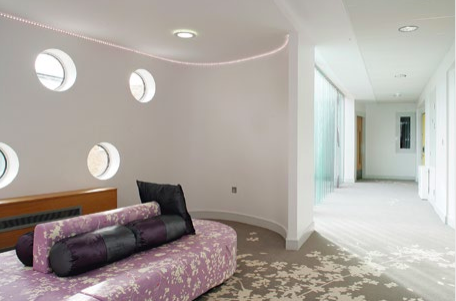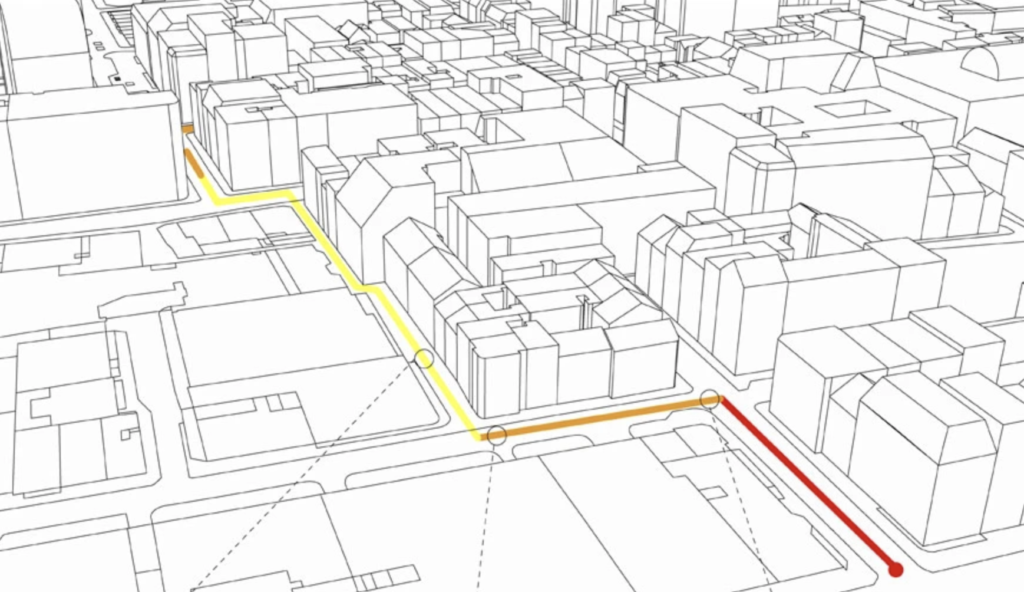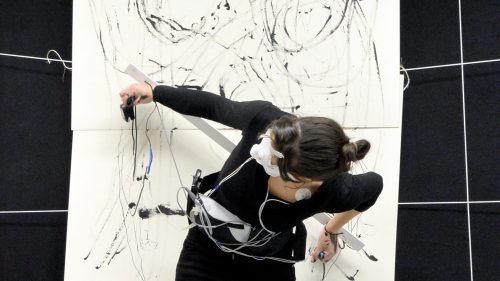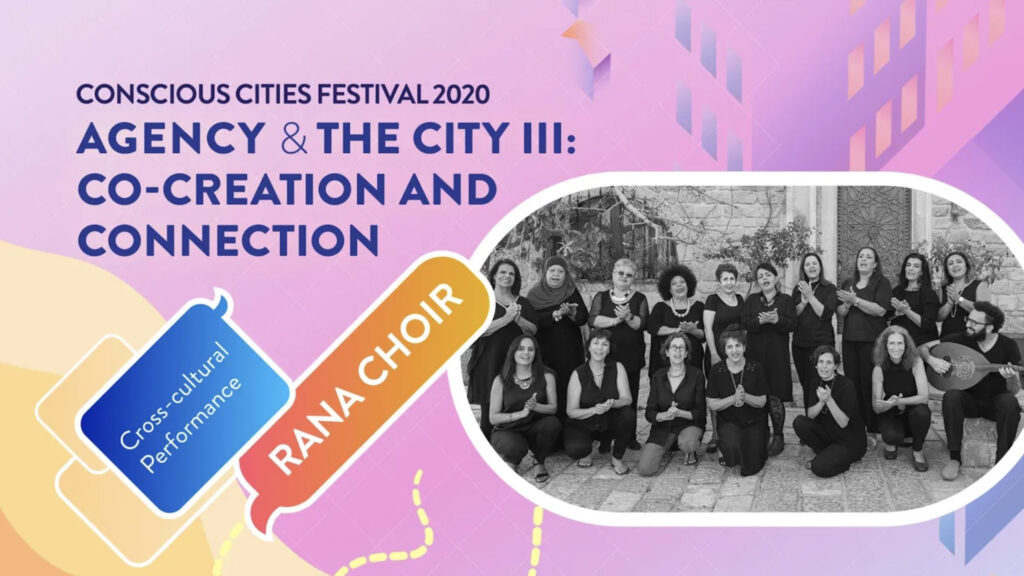The concept and discussions on the importance of the built environment for improved patient outcomes date as far back as 400 BC with Hippocrates1.They evolved in the second half of the 19th century when Florence Nightingale philosophized her Environmental Theory and discussed the benefits of adequate ventilation, windows for natural light, odor reduction in rooms and outdoor views on patient outcomes. Despite these discussions, medical facilities are still perceived as cold and impersonal spaces and could use design interventions, in a much better way, as a lever of change.
Last summer I, along with my team, worked at the Johns Hopkins Children Center Outpatient Clinic hoping to improve patient satisfaction by cutting down on wait times. With the healthcare space moving from the fee for service model to the value-based care model, it was imperative to improve patient outcomes. We noticed that the design of the clinic was such that the patients got lost after coming out of the examination room, increasing the throughput time by a few minutes. By simply using floor signages, the patient throughput time and subsequently the patient wait could have been reduced. This, in turn, would have increased patient satisfaction. Such a research-informed design gives us evidence that the hospital-built environment influences patient outcomes.
We are currently in the Third Era of Health that focuses on preventative and curative health management regimes. The first two focused on communicable diseases and chronic illness respectively. With the rise in chronic and lifestyle-related diseases, there is a grave mismatch between the demand and the supply of hospital services. In this third era of health, architecture is playing a major role by creating environments that reduce levels of anxiety and stress, increase social interaction, and shorten recovery period, thus affecting the healing processes2. The design movements that are gaining tractions in healthcare settings are the theories of Biophilia, Biomimicry and Salutogenics.
Biophilia
The biophilia hypothesis focuses on humans’ innate nature of identifying with natural patterns and environment and its rich diversity in colors, sizes, shapes, and life. American psychoanalyst, Erich Fromm, first used this term in his book, ‘The Anatomy of Human Destructiveness (1973). The concept revolves around the natural world and its divisions into living and non-living nature. The living nature consists of the flora and the fauna; and the non-living nature consists of water, sunlight, temperature, soil and the oxygen we breathe.
Chalk-hill Child and Adolescent Mental Health Unit in Haywards Heath, West Sussex (2008) exhibits biophilic design, where the unique woodland location blends with the interior spaces in the hospital. This exposure affects psychological and emotional disposition and hence the physical well-being (Mazuch, 2017) .

A de-stigmatizing mental-health environment, using natural biomorphic forms and patterns within fabric and finishes, celebrating its connection with protected woodland.(3)
However, most hospitals are in urban areas might not have the luxury of windows that overlook nature or of beautiful landscapes. Windows are the most common way to connect a patient with the natural elements. According to a study in the US, two nature themed window murals led to improvements in heart rate and systolic blood pressure in pediatric patients4 thus demonstrating the efficacy of biophilic designs. However, it should also be kept in mind that biophilic design is not simply integrating nature into built environment but it also consists of an understanding of the complex human-nature relationship5.
Biomimicry
According to Biomimicry Institute, “Biomimicry is an approach to innovation that seeks sustainable solutions to human challenges by emulating nature’s time-tested patterns and strategies”6. We long for nature by living in an artificial environment and to satiate the longing, we try to mimic the complexity and geometrical properties of natural organisms by creating ‘living structures’. This complex environment fuels the development of brain size and cognitive abilities and increases performance on intelligence tests7. The main difference between biophilia and biomimicry is that the biophilic systems connect humans, both physically and emotionally, to natural world whereas the biomimetic systems directly use the systems and patterns from nature into human built and human serving environments8.
Biomimicry is being used to design surfaces in hospital settings. One of the chief reasons for Hospitals Acquired Infection is biofouling that causes $20 billion in healthcare costs every year. Biofouling is the accumulation of organisms such as bacteria on surfaces. Toxic chemicals are generally sprayed on surfaces to kill bacteria but over time these organisms develop immunity for the chemicals. Architects and scientists mimicked sharkskin to design uneven and micro topographic surfaces. These surfaces created gaps that stressed bacteria’s cells thus requiring bacteria to spend more energy and hence reducing bacteria’s ability to survive9. Some researchers showed that the new surface decreased bacterial contamination with log reductions ranging from 87% to 99%10.
As the design industry becomes greener, it has no shortage of role models in nature. A stronger understanding of these relationships will produce better biomimetic designs that will not only minimize the harmful effects on the natural environment but also advance health outcomes.
Salutogenics
Salutogenic healthcare environment is also being promoted in hospitals. The salutogenetic model focuses on the relationship between health, stress, and coping. It posits that coherence is shaped by one’s life experiences and that the sense of coherence helps in coping with stress and tensions. It is based on three broader domains: “(1) comprehensibility (to compromise and negotiate life challenges), (2) manageability (to manage daily physical realities in order to maintain homeostasis), and (3) meaningfulness (to desire living and to resist the entropy of sickness and extinction)”11.
It focuses on human health and hygiene rather than disease and its causes12. Lady Cilento Children’s Hospital is a hospital that is designed using Salutogenics. It resulted in a space that was not only bright and welcoming for both patients and their families but also fostered collaboration between the hospital’s multi-disciplines13. The layout was inspired by a living tree with light-filled atriums and double height spaces branching out.

Initial studies showed that the design strategies at the hospital improved experiences for patients, families and other building users13. Armed with new technologies, innovative models of care, augmenting evidence-based research and interweaving of humanist principles and architectural design, therapeutic architecture is able to create and choreograph spaces that can definitely prolong life, and heal our future healthcare environments.
Conclusion
In the 21st century, healthcare architecture is undergoing swift renovation. Architects are using human-centered design as central elements in planning. They are designing new hospitals by empathizing with patients, understanding their social and psychosocial needs and understanding patient’s hospital experience. Salutogenic principles are being used with biophilic attributes and patterns to create healthcare facilities11.

Owing to the diverse stakeholders in the hospital setting, the human (our center of the design) has never been a homogeneous one. Some thrive in high technology environments, while others have specific sensory or emotional needs. The concept of theoretical design, data, and technology can bring insights, improve human-centered outputs, and provide impetus in new research for health care design that leads to improved or new models, strategies, and methodologies.
References
- E.R.C.M.Huisman, E.Morales, Hoof, J., & H.S.M.Korta. (December 2012). Healing environment: A review of the impact of physical environmental factors on users. Building and Environment Volume 58, 70-80 .
- Douglas, C. H., & Douglas, M. R. (2004). Patient‐friendly hospital environments: exploring the patients’ perspective. Health Expect, 61–73.
- Mazuch, R. (2017). Salutogenic and Biophilic Design as Therapeutic Approaches to Sustainable Architecture.
- Pearson, M., Gaines, K., Pati, D., Colwell, M., Motheral, L., & Adams, N. G. (2019). The Physiological Impact of Window Murals on Pediatric Patients. HERD: Health Environments Research & Design Journal, 116-129.
- Totaforti, S. (2018). Applying the benefits of biophilic theory to hospital design. City, Territory and Architecture.
- The Biomimicry Institute. (2019). Retrieved from https://biomimicry.org/what-is-biomimicry/
- Salingaros, N. A. (2015). Biophilia and Healing Environments: Healthy Principles For Designing the Built World.
- Iouguina, A., Dawson, J., Hallgrimsson, B., & Smart, G. (2014). Biologically Informed Disciplines: A Comparative Analysis of Bionics, Biomimetics, Biomimicry, and Bio-Inspiration Among Others. Int. J. of Design & Nature and Ecodynamics, 197-205.
- Michel, Y. A. (2015). Biomimicry and Innovation in Sustainable Design: Understanding its Innovation Supporting Characteristics Compared to Ecodesign. Montreal.
- Mann, E. E., Manna, D., Mettetal, M. R., May, R. M., Dannemiller, E. M., Chung, K. K., . . . Reddy, S. T. (2014). Surface micropattern limits bacterial contamination. Antimicrob Resist Infect Control, 3:28.
- Abdelaal, D. M., & Soebarto, P. V. (2018). The Death of Modern Hospitals: Towards a Comprehensive Approach for Restorative Healthcare Environmental Design.
- Mittelmark, M. B., & Bauer, G. F. (2017). Chapter 2: The Meanings of Salutogenesis. In The Handbook of Salutogenesis [Internet]. Springer.
- Lyon, C. (2017, March 1). Humanist Principles, Sustainable Design and Salutogenics. Architectural Design.









